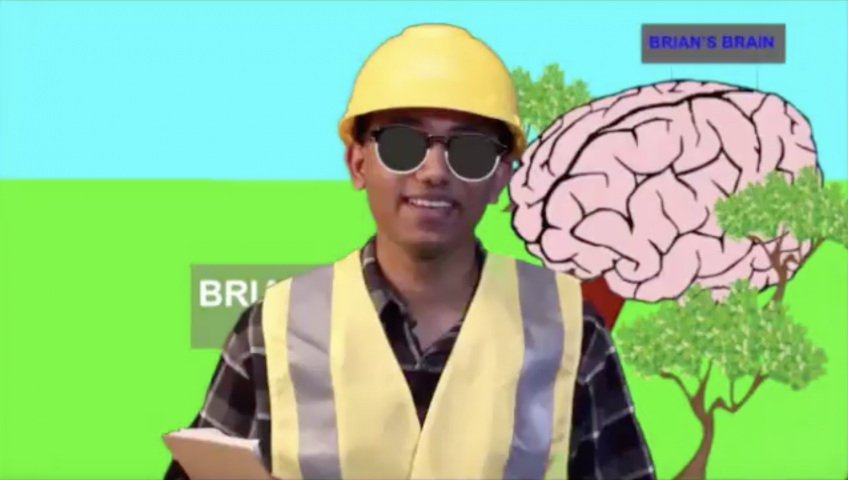Here is the transcript for the video Brainstruction: A Journey Through Brian’s Brain addressing the childhood neurological condition cerebral palsy. This video was made as part of the Brain Awareness Video Contest 2018 organized by the Society for Neuroscience. Check out the full video by clicking on the link below.
Hello everyone! My name is Siddhant Kumarapuramganapath and I am a construction laborer in baby Brian’s Brain Building. I am here to take you on a tour through Brian’s brain and to ask for your support in this project of making children like Brian feel better. Like all babies developing in their mother’s bellies, Brian has braintainers like me to maintain his mental warehouse. My specific job is to make sure Brian’s brain functions properly. Unfortunately, we are facing a problem here. Poor Brian is being challenged with the disease that may make it hard for him to move in the future– Cerebral palsy. At first, we were not sure why this condition had occurred as there are many ways in which cerebral palsy can happen. Sometimes, the baby can acquire the condition congenitally. We knew this was not possible since we witnessed the symptoms after birth. There were still many other possible explanations such as an injury, bleeding causing intracranial hemorrhage, or low blood flow causing a lack of blood flow to the brain. So, what did happen? With all these possibilities, we sent our team of field investigating braintainers to survey Brian’s brain. We are here where they started, the blood vessels. Let’s see what it says here…it says here, “Blood flow was normal. However, the blood does not supply adequate oxygen.” Hmm, interesting the taps in the brain poured out blood with a lack of oxygen. How did this happen? The story is unfortunate. It turned out that two months ago, Brian’s mom experienced a tragic car crash which damaged her umbilical cord. This special cord transported important nutrients to Brian after being filtered out by the placenta. Damage to this cord led to Hypoxic Ischemic Encephalopathy. The condition may create difficulties for Brian. In order to see the impact, let us make our way to the cerebellum, the part of the brain that allows for movement. Right now, we are in the white matter, the hallway of the brain. The lack of oxygen unfortunately led to damage here as well. The condition is called Periventricular Leukomalacia. This is the security room of the building that ensured the motor actions and signals are in line. If they weren’t, then the alarm signal would turn on and this part would take control to coordinate the signals. In the future, this damage may lead to baby Brian facing ataxia, a condition causing shaky actions. With hard work, these children can lead normal and happy lives, but we must still help them. As braintainers, though, we could not do much ourselves. We needed help from scientists outside of our little world. It is truly amazing what they have done. We are now going to the umbilical cord. Dr. Evan Snyder from Harvard Medical School discovered and experimented, for the first time ever, with the body’s all purpose building blocks– stem cells. He successfully tested this amazing tool on brain injuries in mice. After this, many have been trying to use stem cells to treat cerebral palsy and other diseases. But where are these treasured bricks? There are truckloads of them here, in the umbilical cord. Here stem cells come from mommy so the blocks can suit Brian. In fact, many mothers keep their babies’ stem cells today in order to treat potential disorders in their children without the body rejecting the cells, a common problem in the past. Many stem cell successes have been discovered and more research is underway. Hopefully, one of the discoveries can apply to cerebral palsy. That is not all, though. There are many other interesting techniques being used. Scientists are harnessing robotics to reinforce muscles. Dr. Gene Goldfield at Boston Children’s Hospital has utilized this technique to help children with cerebral palsy. This allows for easier mobility. Unfortunately, the time has come for us to make our way back to the entrance. In many cases, cerebral palsy may have no significant effect so affected children can lead normal lives. But in other cases where symptoms are manifest, a cure can help impacted children. Therefore, as a society, we should help treat and potentially cure cerebral palsy so everyone can lead easier lives. With that, I thank you for joining me on this tour through Brian’s brain and I hope you learned a lot more about cerebral palsy.
Please Click Here to See the Full Video
Author: Siddhant Kumarapuram
